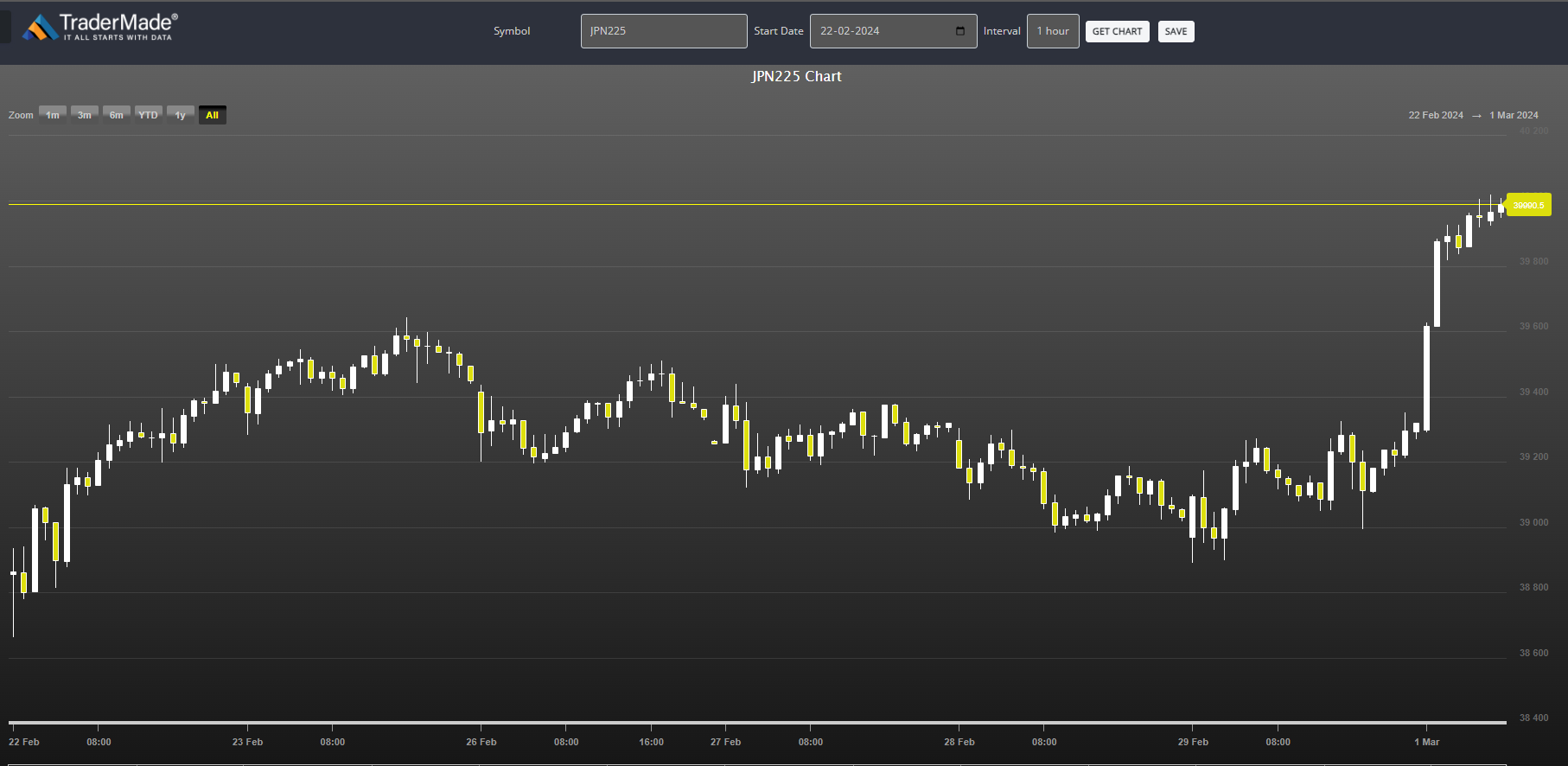
Asia-Australia Stocks Hit New Highs
London: 1 March 2024 (TraderMade): Asia and Australia witnessed a remarkable surge in stock prices on Friday, mirroring the positive sentiment that swept through Wall Street the previous day. Crucial US inflation data coming in line with market expectations caused this upswing.
Key Takeaways
- Nikkei 225 and S&P/ASX 200 reached record highs, while China and Hong Kong saw moderate gains.
- PCE price index aligned with forecasts, easing concerns about an immediate Fed rate cut.
- S&P 500 and Nasdaq closed at record highs, boosting investor confidence.
- Factory activity contracted, but the services sector improved, suggesting an uneven recovery.
- Market participants anticipate stimulus measures at the upcoming parliament meeting.
Market Soars in Asia and Australia
- Japan's benchmark Nikkei 225 (JPN225) index reached a historic peak, closing 1.9% higher at 39,910.82, marking a significant milestone for the Japanese market.
- Australia's S&P/ASX 200 (AUS200) index reached a new record high, finishing the day 0.6% higher at 7,745.60.
- China's mainland markets displayed a more moderate increase, with the CSI 300 index rising 0.4% and the Shanghai Composite gaining 0.39%.
- Hong Kong's Hang Seng (HKG33) index joined the upward trend, ending the day 0.6% higher.
Nikkei (JPN225) Weekly Performance Analysis (23 February - 1 March 2024)
The Nikkei 225 experienced a volatile week, ending positively despite facing downward pressure throughout most of the trading period. Here's a breakdown of its performance:
- Opening and Closing: The index opened the week at 39,432.5 on 23 February and closed at 39,989.69 on 1 March, representing a weekly gain of 1.44%.
- Intra-week Movement: The Nikkei faced downward pressure for the first four trading days, with the closing price on Wednesday, 28 February, being the lowest of the week at 39,031.

- Friday's Surge: However, the index witnessed a significant upward trend on the last day of the week, closing at a new all-time high of 39,989.69. Positive US inflation data and a rally in global markets likely influenced this surge.
- Volatility: The weekly range for the Nikkei was 736.39 points, highlighting the intra-week fluctuations experienced by the index.
Overall, the Nikkei's performance this week can be categorized as volatile with a positive outcome. The initial downward trend was reversed by a significant rally on Friday, pushing the index to a new record high.
Factors Fueling the Rally
US Inflation Data Meets Expectations
Investors were relieved to see the US personal consumption expenditures (PCE) price index, a key gauge for inflation monitored by the Federal Reserve, rise by 0.3% in January, aligning with market forecasts.
This scenario helped alleviate concerns about an immediate rate cut in June, easing some pressure on the market.
Positive Performance on Wall Street
The positive momentum carried over from Wall Street, where the S&P 500 and Nasdaq closed at record highs on Thursday, further bolstering investor confidence and risk appetite in the broader market.
Mixed Signals from China
While China's factory activity contracted in February, indicating ongoing economic challenges, the services sector displayed signs of improvement, suggesting a potential uneven recovery for the world's second-largest economy.
Anticipation of Chinese Policy Support
Market participants look forward to the upcoming annual parliament meeting in China, where they anticipate announcements of additional policy support measures to stimulate the economy.
In Summary
The positive sentiment emanating from Wall Street and the reassuring US inflation data fueled a significant rally in Asia-Australia stock markets. This uptrend resulted in several key indices reaching historic highs, demonstrating increased investor confidence in the region's economic prospects.
However, it is crucial to acknowledge that the situation remains dynamic, and further developments in global economic factors and policy decisions may influence future market trends.


